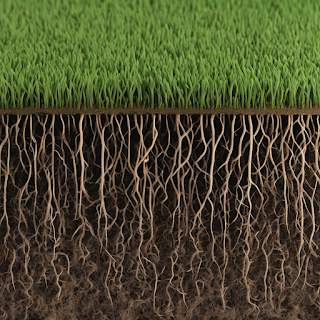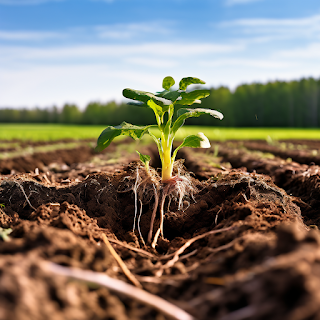While soil nutrients, organic matter and microbial activity receive much focus in discussions around soil health, one often overlooked factor is equally vital - oxygen. As the final electron acceptor in aerobic respiration, oxygen fuels the metabolic processes of plant roots and soil organisms that drive nutrient availability, structure formation and overall productivity. However, many agricultural soils suffer from poor aeration status due to compaction from heavy machinery or over-saturation during rainy seasons. This lack of oxygen inhibits root and microbial functions, limiting nutrient uptake, crop yields and resilience to stresses over time.
Advanced aeration techniques hold promise to remedy this issue through physical modifications that introduce air pores and channels into compacted soils. Some novel approaches being researched include deep ripping, subsoiling, air injection, and subsurface drainage amendments. When paired with cover cropping and reduced tillage, these strategies can potentially transform soil structure, oxygen diffusion rates and rooting depth over multiple seasons. This article explores the importance of root zone aeration and reviews emerging techniques showing promise to remedy oxygen deficits in a sustainable manner through physical soil remediation.
Oxygen's Role for Plant and Soil Health
While often overlooked, oxygen availability profoundly influences belowground processes and plant health. As a terminal electron acceptor, oxygen drives aerobic respiration in plant roots and soil microbes, fueling nutrient transformations, carbon dioxide release and energy generation through cellular respiration:
- Oxygen diffusing into root tissues is required for nutrient and water uptake via proton pumps in root epidermal and cortical cells.
- Soil microbes depend on oxygen to break down organic residues through extracellular enzymes, releasing mineral nutrients in plant-available inorganic forms.
- Mycorrhizal fungi form intimate root associations fueled by plant carbon but require oxygen diffusion to carry out their role in phosphorus solubilization.
- Beneficial aerobic soil bacteria like nitrifiers mediate nitrogen transformations from ammonium to nitrate, a key process in the N cycle.
When oxygen levels decline below 5-10% of soil pore space, these critical functions are impaired, limiting rooting depth and nutrient recycling. Compaction restricts gas diffusion while saturation consumes oxygen through microbial respiration. Both scenarios strand roots in hypoxic conditions with dire impacts on fertility and yields.
Advanced Aeration through Physical Remediation
Given oxygen's importance, improving aeration status represents a core strategy for regenerating compacted or waterlogged soils. Conventional practices like deep plowing are ineffective long-term and damage structure but novel physical methods show promise:
- Deep ripping/subsoiling uses heavy-duty shanks or teeth to fracture dense pan layers and hardpans below the plow layer, opening deep channels for root/gas penetration.
- Air injection forces compressed air into soil via narrow tines, loosening structure without inversion. Micro-pores persist for years versus plow pans.
- Drainage amendments like gravel or geotextile bands installed below tile lines accelerate water removal from saturated zones during rainy periods.
- No-till combined with cover crops builds porosity near the surface while deep techniques simultaneously remedy compacted subsoil layers.
By physically altering soil structure instead of disrupting it, these advanced strategies can potentially transform aeration status over multiple seasons versus temporary tillage impacts. Careful implementation is still required to avoid compaction from heavy machinery.
Deep Ripping Trials on Vegetable Farms
Researchers at our land grant university recently completed on-farm trials evaluating deep ripping (DR) for vegetable production on silty clay loam soils prone to compaction. The objective was to assess impacts on rooting depth and distribution, soil structure, and crop water use/yields over three growing seasons:
- Year 1 - DR was performed to 60cm depth prior to winter cover crop planting. Soil structure to 30cm improved markedly based on reduced bulk density.
- Year 2 - Snap bean yields were 15-20% higher on DR plots with deeper, more extensive root systems. Seasonal water use decreased 10-15cm.
- Year 3 - Sweet corn, bell peppers and cabbage showed similar yield boosts on DR areas with deeper intakes. Soil structure persisted to 60cm depth.
Overall, DR successfully remediated a dense fragipan layer, transforming aeration status. Cover cropping maintained improvements versus tilled controls. Deeper rooting access to water and nutrients enhanced crop productivity with less irrigation.
Subsoiling and Air Injection for Pastures
A multi-state initiative examined subsoiling and air injection techniques to remedy compaction in intensively grazed pastures. Soil strength was measured before and after treatments on silt loam soils with a dense plow layer at 20cm:
- Subsoiling to 40cm using heavy shanks reduced penetration resistance by 30-50% to 18 months post-treatment.
- Air injection formed stable microaggregates that persisted 2+ years. Soil strength declined 15-30% to the 30cm depth.
- Forage yields increased 15-30% on treated areas with deeper rooting volumes versus controls.
- Herbaceous ground cover improved markedly with less runoff and erosion observed.
Notably, combining subsoiling and air injection produced synergistic impacts, transforming both the plow layer and subsoil structure long-term. Strategic remediation enhanced pasture productivity and environmental quality.
Optimizing Implementation of Physical Aeration
While showing promise, physical aeration techniques require careful planning to avoid compaction and achieve full benefits:
- Soil moisture content must be below field capacity for effective fracturing without smearing/sealing pores.
- Equipment should apply minimum pressure to prevent subsoil re-compaction from heavy wheel traffic.
- Strategic timing coordinates with cover crops to maintain porous structure without inversion tillage impacts.
- Depth and spacing are tailored to specific soil types and compaction layers below the plow layer.
- Multi-year programs may be required for full structural reconditioning on severely compacted sites.
When carefully implemented as part of an integrated soil health system, advanced aeration strategies can potentially transform root zone structure, oxygen diffusion and water infiltration over the long-term for regenerative agriculture. Paired with no-till and cover cropping, physical remediation remedies a core limitation in soil fertility.
Conclusion
In closing, root zone aeration represents a missing link in soil health that is increasingly recognized for its influence on belowground processes and plant productivity. While often overlooked, maintaining adequate oxygen levels within soil pore space is equally vital as nutrient and organic matter management. Novel physical techniques show promise to remedy oxygen deficits limiting rooting depth and nutrient cycling functions in compacted or saturated soils on cropland and pastures.
Strategic implementation as part of regenerative programs can potentially transform aeration status, unlocking soil potential through enhanced belowground activity fueled by atmospheric oxygen over multiple growing seasons. With careful research and adoption, advanced aeration approaches may play an increasing role in sustainable soil management globally.


Post a Comment